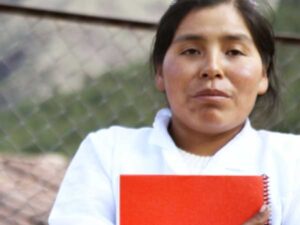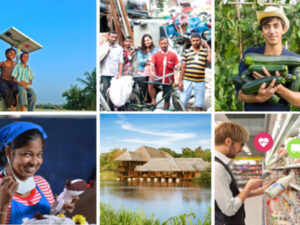Living Landscapes + Common Ground leverages the Commons to address linked crises of livelihoods, climate, and equity, through a system-wide collaborative action framework.
Jagadessh Puppala of Living Landscapes + Common Ground spoke with Ambika Samarthya-Howard on July 1, 2025. Click here to read the full conversation with insights highlighted.
Ambika Samarthya-Howard: You’re working with Common Ground and a few other climate organizations. Please talk about how everyone’s connected.
Jagdeesh Puppala: Common Ground is a collaborative initiative anchored by Living Landscapes, a.k.a Padraka Foundation, designed to address the interlinked crises of livelihoods, climate, and social equity. Co-created in 2023 with 23 partners, it has since grown into a distributed network of 66 partners and over 75 initiatives in the last one and a half years.
Rather than acting as a single implementing agency, Common Ground strengthens grassroots actors, aligns policies and financial flows, opens equitable market opportunities, and catalyses collaborative action across sectors and geographies. The goal is to build the capacities, systems, and relationships needed for rural communities to meaningfully determine and shape their future.
We realized that the pace and scale at which this climate vulnerabilities are happening — and for that matter, biodiversity losses, groundwater depletion, inequalities or rural economic distress — had to be addressed meaningfully. One big ship is not enough; you need a flotilla of boats.
The capacity of the ecosystem to respond to today’s challenges is limited, and solutions often remain fragmented. We asked ourselves: how can we bring together the strengths and capabilities of several organizations so that rural communities can shape their own aspirations and take concrete action, for both people and nature? Common Ground emerged from this question, as a way to build collective capacity and enable communities to lead change on their own terms.
Living Landscapes is the backbone organization to serve the collaboration of these 23 organizations. I’m the Chief Executive and the convenor for the collaborative. Over the last one and a half years, they have become 66 organizations.
Ambika Samarthya-Howard: That’s a huge scale-up. Are you all working with climate, or is Common Ground the only climate thing you’re doing?
Jagdeesh Puppala: The partners in Common Ground come from diverse backgrounds, but they’re connected by a shared concern for the link between people, nature, and livelihoods. Many of them work on rural livelihoods, some focus on ecological restoration and natural resource governance, and others bring expertise in policy, markets, and local governance.
Among these 66 organisations, we also work with enabler organisations, those designing market and policy instruments, data systems, tech tools, and analytics.
Ambika Samarthya-Howard: Whenever I speak to people in India, it almost always comes back to work around livelihoods and not specifically climate. Could you talk about the climate landscape in India versus other parts of the world?
Jagdeesh Puppala: Brazil, Indonesia, and Congo are the favorite spots for tropical forests. India is a subtropical country, and we have the Western Ghats. If funders could broaden their focus beyond a few concentrated geographies, it would open up greater opportunities to learn from diverse contexts and exchange insights across regions. Right now, many investments are clustered in the same areas, which has led to a concentration of organisations working there.
Over the last 30 to 40 years, much of India’s civil society has evolved around human development, livelihoods, production systems, agriculture, livestock, and non-farm enterprises. Conservation, on the other hand, was largely seen as the domain of the forest department, which meant that many non-profits and community-based organisations were not deeply engaged in ecological restoration or natural resource governance. That historical separation between livelihoods and conservation is something Common Ground is trying to bridge, by bringing these strands together and placing people, nature, and governance within the same frame.
Except for a handful of organisations that began in the mid-1980s focusing on both ecology and people together, most of India’s conservation efforts have evolved differently. Growth in this space has been strong around research institutions and think tanks, which are well-established and play a critical role in shaping knowledge and policy. But when it comes to translating this research into community-led action on the ground, there are only a few national organisations doing it at scale. Many international conservation efforts, like WWF and others, have historically focused on charismatic species, tigers, elephants, butterflies, which are important, but they often leave out the equally critical connections between commons, livelihoods, and local governance.
My previous organization grew to a reasonably big organization from the mid-80s to the 2020s, saying that the connection between nature and people is important. There are several small organizations, but but they may not have been able to achieve scale.
Ambika Samarthya-Howard: When I’m talking to the people in Brazil or looking at the landscape, it’s a lot of work on the quilombolas, the Indigenous people, and the bioforestry economies. How do we sell oils? How do we sell beauty products? How do we sell medicines? What are the primary concerns or the primary strategies that are happening in the Indian landscape?
Jagdeesh Puppala: Let’s go to the land rights part of it. We worked on three kinds of so-called communal lands in India. In Tamil Nadu, they call it Poramboke, and South Tamil Nadu has many such revenue wastelands. You will find wastelands in several parts of the peninsular of India; in Rajasthan, Gujarat, Maharashtra, and Madhya Pradesh. It’s a colonial remnant; the land was considered unproductive for taxation and labeled by the queen as “wasteland.” Unfortunately, even after 75 years of freedom, we still have “wasteland” as the nomenclature, and these are sizable lands.
Ambika Samarthya-Howard: Is “wasteland” exactly as the word labels it?
Jagdeesh Puppala: Yes, it’s community land that’s used for firewood, fodder, medicine, and hunting. Scrub lands that are valuable for the ecosystem because of the hydrological and ecological cycles. They host a range of spiders, pollinators, pest-controlling insects, including mammals, and so on.
Unfortunately, over time, these landscapes have often been dismissed as “wastelands” because they don’t generate direct tax revenue. Government’s attention has tended to prioritize converting them into “productive” uses—mining, special economic zones, or urban expansion—while the ecological economy that sustains village life has been undervalued and overlooked.
The second kind of land in India has been given to the lowest form of governance, called Gram Panchayat. These are set aside, particularly for grazing. In Rajasthan, they are called Charaga and they are vested with the Gram Panchayats or Village Councils. A portion of 5% or, depending upon the livestock population, a certain portion has been set aside for village grazing purposes. They have similar names in other parts of India, like Gomala in Karnataka, Gairan in Maharashtra. All such lands are essentially set aside for grazing.
The third one is forest lands. It’s been a historical injustice where forest inhabitants, tribal people, our Indigenous people, have not been assigned those lands.
In 2006, the historic Forest Rights Act (FRA) was enacted, with an intent to rectify historical injustices caused by colonial policies. It’s a dramatic development in the Indian policy space, to recognize the association of tribal and forest together, and not only give individual lands but also community lands.
These are the three big policy spaces regarding community lands in India. We have played a role in all three. Regarding the revenue wastelands, we were the first ones to bring in a lease arrangement where the government leases this land to the village collective.
It was a big struggle, but in five states, the government started leasing about 100 acres for each village, for a term ranging from 20 to 99 years, and the period was renewable.
Ambika Samarthya-Howard: How did you make that happen?
Jagdeesh Puppala: Negotiation. Making them see that these lands are degraded and the government’s assumption that they would manage it from distant state capitals doesn’t work on the ground. If village people were given these lands, they would capably manage them. Governments have historically had little faith in the capabilities of local people to manage their resources. It happens all over the world. Elinor Ostrom got the Nobel Prize in Economic Sciences in 2009 for disproving this notion. She provided evidence that village people can manage their resources if the enabling conditions are in place.
This important Nobel Prize recognized the unnecessary control that governments exercise in managing village resources. We had to negotiate with the government that these lands are productive or could be made productive by involving local communities. There was an energy crisis during that period and governments were receptive. We presented that such lands could meet the basic needs of firewood, fodder and small timber. One government agreed, and subsequently five governments agreed.
Ambika Samarthya-Howard: I know in India that every state government is different and that negotiations and doing political stuff is not a one person’s full-time job. It’s like 40 people’s full-time job. Do you have any tips or advice for people trying to do that work?
Jagdeesh Puppala: You have to cultivate relationships without any expectation. Evidence matters. Show them good work that pays off in the long run. You have to be persistent. Sometimes they ask for data and evidence, and you have to go almost the very next day and present the evidence and seize the opportunity. Mind you, in those days, we didn’t even have photocopiers.
Similarly, my colleagues did it in many other states. We also had the backing of the National Dairy Development Board, which was known worldwide for Milk Cooperatives, which added to the credibility. You need credibility, good relationships, solid evidence, and heavy professionalism in being punctual and getting back to them.
The Forest Act became an act. There was good evidence. Its translation into reality on the ground is taking time, but like any other act or policy, it follows its course, and we are doggedly working on it. In terms of lease, what we imaginatively did…
Ambika Samarthya-Howard: Is lease the same thing as land rights?
Jagdeesh Puppala: Lease is not total alienation. The government leases it to you for a period of time for certain purposes.
Ambika Samarthya-Howard: Why would anybody want to do that as opposed to just getting full land rights?
Jagdeesh Puppala: Because you don’t have enough trust in the other party. You want to test it out. You will give it for 20 years and see if they are managing well, and then extend the period of lease.
Lease is an inferior form compared to the Forest Rights Act, but it was good enough to start with. When you have that foothold, you can say, the village people have managed well, now extend it by 99 years instead of just 20 years every time.
The other part is to increase the size. In the 1970s, when grazing lands were assigned to the panchayat, they did it based on the livestock census. Typically, if you have five cattle heads, you are allowed one acre or half an acre, and, depending upon the cattle census of that particular village, that much portion of land was given to them. In the early 2000s, we went back to the government and asked them to increase the extent of land as the livestock population increased. We asked them to consider the recent livestock census in deciding the extent of land, and they agreed.
In the 70’s, the land extent was decided based on the census on cows and buffaloes, cattle, and not for sheep and goats, but we highlighted that the contribution of sheep and goats to the livestock economy of the state was significant and that they be included in determining the extent of land. They agreed, and the extent of land to be governed by local communities increased substantially.
Land is a highly contested issue, and governments have a stronghold on it. People recognize private individual property or corporations, but never look at collective property. We need to present evidence that local communities can capably manage and continue to elbow spaces for community land or communal land besides the dominant push for individual ownership or government control. If I look at my professional background from the mid ’80s to now, there’s considerable acceptance of looking at communal property as good as individual private property.
Ambika Samarthya-Howard: How does the funding model work? Is there a need for funding, and if so, where, and does that come from the government?
Jagdeesh Puppala: India is different. We have the Right to Employment Guarantee Act. It’s a God sent for us. Any village person, man or woman, can register and claim for a hundred days of wages.
It initially started in a few districts and spread across the country. It was a big success. Now, public money rightly goes to these degraded or neglected lands. A big chunk of it is available. Something like $5 billion every year gets channeled into these lands from the government.
India has a direct benefit transfer system where the money directly comes from New Delhi or Hyderabad into the person’s individual account, to the right individual. It is a good step because it reduces leakages in the system. However, there’s a big challenge. There were two parallel approaches. Firstly, there was something called individual focus, where schemes were developed to focus on individuals. Like, if you are a woman, if you are a widow, you would get so much entitlement. If you have a girl child, you may get X amount as subsidy. That was the individual-oriented approach.
The second half of it was area-based, which means the funds were allocated depending upon a geographical focus, like drought prone areas or watershed areas. Area-based spending used to happen. With these direct benefit transfers, everything goes to the individual. It doesn’t necessarily go into restoring the ecosystem. The money is there, and it’s good money; however, we had to get imaginative about how individuals collectively plan for their whole village or landscape and restore that entire landscape rather than their backyard. That’s what we are currently working on.
The third set are new emerging financial instruments like outcome accelerators, blended finance, and a range of other new products like carbon credits, biodiversity credits. All these are important to address the ecosystems. A combination of Corporate Social Responsibility (CSR) money is also good in India. How do you bring in CSR money? How do you bring philanthropy money? How do you bring carbon biodiversity money? How do you bring these new financial instruments?
That is what we are working on so that you have a place-based investment happening; this particular landscape needs to be developed for forests or for pastures, what kind of products, and who could cover which part of that funding requirement? Philanthropy could fund the most untouched part of it. CSR could fund the concrete, quantifiable activities. Governments could support long-term restoration efforts; governments could also support skill building among forest enterprises. These combined with new instruments could bring in additional capital to build the economy and entrepreneurship and hopefully weave in a risk taking appetite. Together we could imagine a local village economy that is based on the natural assets of the area and an economy that centers the agency of local communities, enhances their skills and entrepreneurship. Such an economy would be much more comprehensive than the mainstream panacea that carbon credits are touted as.
Ambika Samarthya-Howard: There is a big disparity between how fuel and financing are talked about in the global north versus the global south. We talk about methane, clean fuel, and carbon credits. I don’t think that resonates with almost any of the organizations I have spoken to. I was curious if you could explain what’s myopic about it?
Jagdeesh Puppala: Carbon and biodiversity credits are very reductionist because the way communities, particularly tribal communities, live in close association with their forests — their names and identities come from the forests and rivers — is not just one product. It’s a combination of various cultural, social, and economic associations with a resource system. These market instruments are good, but they shouldn’t be the only ones. The problem with carbon is that it’s like the productification or commoditization of one part of an ecosystem. It’s not the whole ecosystem. It’s not looking at biodiversity, hydrological, or pollination services. Or the various other social interactions, like collective decision-making, stewardship, rewards, and punishments, that the village people engage in to protect the forest.
By picking up only carbon, they’re disregarding the various other ecological values that are associated with that.
Once they understand that they should also look at biodiversity, water, and so on, they call it co-benefits. The problem with the co-benefit is that if there is no carbon, they won’t look at any of these co-benefits. It is carbon-centric and not the whole range of ecological functions and services that an ecosystem offers for human survival and thriving in that area. It is reductionism or tunnel vision for these products. Today it’s carbon, tomorrow it’s biodiversity, but you need a range of all of these to come together. That’s how village people have been custodians and stewards of their forests for centuries. That is missing.
Secondly, the downside of this is that there is poor faith between the buyers and sellers. The buyers, typically corporations, do not have faith in the way the local stewards protect their forests. Similarly, the village people who are the sellers do not have faith in how those markets come in because they are very distant. How to improve the faith so that the village person can sit at the negotiation table as an equal?
Property or land ownership is not enough. Ownership of what grows above it and what is under it is equally important, because otherwise, you have the land, but what is growing on the land is sold by someone to someone else, and the village people are left hanging dry.
We are thinking about a place-based stewardship arrangement where a range of actors can come in and look at the whole rather than parts of it. This is only at a conceptual stage. There are many failures in the carbon trade. In Australia, China, and Uganda, carbon credit programs or offset programs have failed because the people who certify have made tall claims, and the reality on the ground is very different.
Ambika Samarthya-Howard: Let’s shift to the signatories and the people in Common Ground. I want to understand the organizations that have signed on to the thing. What’s similar about them? What are they signatories to?
Jagdeesh Puppala: The crisis we are facing on climate change, biodiversity losses, depletion of water table or growing inequalities or rural economic distress, cannot be handled by one organization. The 66 organizations realize that together we can. Some people come to bring the voice of the local people. Some people bring friends on data and technology tools, and algorithms. Some people are good at improving the forest produce value chains. Others are good at engaging with the government.
By joining the dots between these people, we can address it at a reasonable scale. As Sanjay Purohit says, “What works at scale is what we need to imagine, not just scaling what is working.”
The second important thing is that in the organizations that I handle, we were good at certain elements, but we were not good at many other elements.
If we come together, we are distributing the ability to solve problems, so that many innovations happen across the geography with plural approaches rather than one blueprint, which typically organizations end up with.
Lastly, organizational entrepreneurship is necessary, but you need ecosystem entrepreneurship, too.
It’s that realization that has made me move on from the Foundation for Ecological Security (FES), my previous organization. It’s a good organization, but we would probably be doing incremental changes. How do we imagine work at a population scale, and how do we see other partners as equal partners? Even in the NGO world, we don’t get along with one another because of the ego-logo problem, as Skoll awardee Tim Hanstad says.
We all know that we have probably not addressed the problem at all, or we are somewhat contributing to it in a small way. If we rise above ourselves, we will contribute to addressing complex, wicked problems like climate change, biodiversity loss, water levels, or inequalities. We have to learn to work with many other people. That is the DNA of Common Ground.
Ambika Samarthya-Howard: Could you give me one or two examples of something you have all done together that changes structures or the system?
Jagdeesh Puppala: There are many things, but two interesting ones come immediately to my mind. Around summer, a good portion of Indian forests catch fire. Typically, people living on the fringes of the forest, tribal people, either face problems from forest fires, human-wildlife conflict, or invasive species.
One example in Jharkhand, where we had a communicators workshop for people into writing stories, like YouTubers, local story influencers, and some 20 to 25 Jharkhand NGO partners. It was an exchange of telling stories to people who are good at writing or designing.
Several issues came up in those three days. One was around forest fires, and 14 village communities effectively came up with rules of safeguarding the forest from the fire with their methods, rules, regulations, and technology. In the same workshop, there were government officials from the forest department.
One of the reporters picked up the story and put it in the local news. The forest department liked the approach because of the clear method and outcome, and issued orders for it to be spread to other forest fire-prone areas in the state. It’s about joining the dots between organizations that have different purposes. Firstly, it was the village communities who came together, and the local NGOs supported it. The media picked it up, the government functionaries saw it as an opportunity to scale.
The other example is about the state of Orissa in East India, which is recognised for promoting an extensive millet mission. Our partner organization, Watershed Support Services and Activities Network (WASSAN), has built up good evidence on the ground of how millet production is good for rainfed areas in terms of production, productivity, and for local nutrition. They worked with a few local NGO partners, and the state government program spread it across the state.
However, some unfortunate developments started happening. The larger system did not fully comprehend the fundamental shifts intrinsic to the millet mission, such as low external input and low-cost cultivation. Applying fertilizers and providing irrigation to further improve the productivity of millet cultivation were being encouraged. The local organizations did not feel confident or capable enough to oppose it at the local level. Some of the NGOs spoke to communicators and journalists and provided evidence of the pros and cons. The government started being responsive and taking corrective action.
You build on strengths of different organizations depending on the need that comes in. It’s not just a working group that is all about words. You need five or six organizations that have complementary strengths. Some people are good at algorithms, analytics, and tools. Others are good at making data stories or stories that are easily comprehensible by the local people. The third organization is good at data privacy, informed consent, and good governance, and the fourth organization on lateral communications.
Suppose there is a village lady who has done some wonderful work on the Right to Employment Guarantee Act. You would conduct a training program, do a trainer of trainers, and take it to some 5-10 other villages. It’s going out of the village domain into a typical NGO, which transmits it. Reap Benefit creates communication channels between villages. A woman in, say, the eastern part of India in one district in Orissa, can talk to another woman in another district and share what she did under the Right to Employment Guarantee Act, and how she earned an additional 230 rupees by following a particular method. The other person will ask what she exactly did. Such village-to-village rather than many-to-many communication improves learning and scaling exponentially instead of relying on NGOs or governments.
Ambika Samarthya-Howard: The communication between these two women. Is that happening on WhatsApp, in person?
Jagdeesh Puppala: We use tools like chatbots and WhatsApp, connected through a platform called Samaaja, which means “society,” managed by Common Ground partner organisation Reap Benefit. Through Samaaja, village residents are invited to share their WhatsApp numbers so they can communicate with one another as well as receive timely information, updates, and support directly on their phones.
Ambika Samarthya-Howard: I would love to hear how you’re feeling about the future. What are you looking forward to in the next five years to see change, and what do you think about COP? What does the year look like for you in terms of the politics, in terms of it being a big climate year, and then the more long-term play?
Jagdeesh Puppala: The more we see the global developments, my faith and my energies will be devoted to ordinary citizens. Climate change can only be addressed if climate action can be shared by every citizen. Instead of excessively relying on government or some outside solution, I would focus on providing good knowledge and good information that leads ordinary citizens to determine their futures.
I intend to be at COP in Brazil. I’m just reluctant about the COPs because of the back-breaking journey; it’s 36 hours of travel. We are in touch with certain groups to present the civil society voice and put the spotlight on local communities as capable custodians of their resources and determinants of their futures. We want to mend this carbon tunnel vision and engage with several others to influence the climate finance part of COP.
We also want to showcase how technology could be a powerful tool to enfranchise local people towards action, and influence other forms of capital into this. Not just government capital, but also philanthropists and blended finance. That’s going to be my agenda at the COP.
Ambika Samarthya-Howard: That’s a very ambitious agenda. Excellent.
Jagdeesh Puppala: Every voice counts. We want to be a part of an ecosystem where we contribute to the solution. We challenge developments that are not so favorable to either nature or to the local people by providing constructive solutions or highlighting the downside of unfavorable decisions.
Ambika Samarthya-Howard: When you were saying in the next five years, the real desire for you is to move this into communities, into citizens. How do you see your work changing?
Jagdeesh Puppala: I would not say the work changes dramatically but my level of effort and energy would increase. If I have to work on policy, markets, finance, data, and technology, and make these macro drivers enhance the voice and agency of local people, I would probably not be spending so much time, if at all, on some corporations that don’t want to change their behavior.
Or if certain governments feel that solar and windmills will answer all the solutions, I would say, good, you’re doing that. Someday look also at adaptation and issues concerning soil health, biodiversity, and so on. They are equally good infrastructure for our country and across the world.
Ambika Samarthya-Howard: What do you need?
Jagdeesh Puppala: What do I need? I wake up every morning feeling all the more charged up, knowing fully well the difficulties. We have chosen a very audacious, wicked problem of collaboration, bringing together several people. I’ve seen the phenomenal strength of this during COVID, where people from different walks of life came together to address issues of hospitals or ventilators, or even with migrants. It is that energy that I rely on, of the goodness in each one, and how we make the best of it. I wake up with that energy every day. Some days are bad, I agree, but most of the days are with that. I’ve spent 40 years in this domain, so I know what good energy is.
Ambika Samarthya-Howard: Knowing that, what is it that you feel like you need? Is it more diverse funding? Is it more unrestricted funding? Is it more like community support? Is it like better narratives?
On the funding side, it’s very clear. I have been lucky in the last three difficult years to start a nonprofit, and all seven funders have given unrestricted funds. Funders are not very familiar with the systems change initiatives. They feel that it is all hot air. How do we improve the confidence amongst funders on the need for system-level entrepreneurship alongside organizational entrepreneurship? Both are equally important.
Ambika Samarthya-Howard: A lot of what you’re saying would be more about changing the narrative, showing the evidence-based, showing the stories.
Jagdeesh Puppala: Yes.
Ambika Samarthya-Howard: That I can help you with, so that’s great. This was awesome, I hope to see you at COP. There’s also been this very organic ask from a few people on the team, both from Asia and Brazil, to start doing some South-South coordination meetings just to hear what people are doing.
Jagdeesh Puppala: Excellent, we’ll see that India is properly represented. Every degree or half-degree change in latitude is going to hit us differently. Climate change is not going to be uniform. Unless we see the whole system, we’ll miss the point.
Ambika Samarthya-Howard: That’s a good place to end. Thank you so much for your time.
Click here to read the full conversation with insights highlighted.
Ambika Samarthya-Howard (she/her) is the Solutions Journalism Network’s Chief Innovation Officer: She leads on innovation and technology, leverages communication platforms for the network strategy and creates cool content. She has an MFA from Columbia’s Film School and has been creating, teaching and writing at the intersection of storytelling and social good for two decades. She has produced content for Current TV, UNICEF, Havas, Praekelt.org, UNICEF, UNFPA, Save the Children, FCDO, Global Integrity and Prism.
* This interview has been edited and condensed.
Read about other social innovators.







